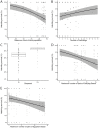Factors limiting reproductive success in urban Greylag Geese (Anser anser)
- PMID: 35945936
- PMCID: PMC9357368
- DOI: 10.7717/peerj.13685
Factors limiting reproductive success in urban Greylag Geese (Anser anser)
Abstract
In the late eighties, Greylag Geese (Anser anser) started to colonise an urban area previously void of geese in southwestern Germany. Between 2004 and 2020, in a period of steady population increase with subsequent population stagnation, we analysed two measures of reproductive success: (1) the relation between freshly hatched to fledged young for each brood and (2) the probability of a hatchling to survive to fledging. We were able to show that the dispersal of pairs from the nesting site to a different brood rearing area resulted in higher reproductive success. However, the increasing population size of Greylag Geese and the number of breeding pairs of recently immigrated Egyptian Geese (Alopochen aegyptiaca) had a negative impact on reproductive success, indicating density dependence. Our results show that newly established populations in urban settings do not grow indefinitely, which is an important fact that should be taken into account by wildlife managers.
Keywords: Breeding pairs; Colonisation; Density dependence; Dispersal; Egyptian Geese; Reproduction; Year effect.
©2022 Mai et al.
Conflict of interest statement
The authors declare there are no competing interests.
Figures




Similar articles
-
From individual to population level: Temperature and snow cover modulate fledging success through breeding phenology in greylag geese (Anser anser).Sci Rep. 2021 Aug 9;11(1):16100. doi: 10.1038/s41598-021-95011-9. Sci Rep. 2021. PMID: 34373490 Free PMC article.
-
Home ranges and movements of resident graylag geese (Anser anser) in breeding and winter habitats in Bavaria, South Germany.PLoS One. 2018 Sep 17;13(9):e0202443. doi: 10.1371/journal.pone.0202443. eCollection 2018. PLoS One. 2018. PMID: 30222745 Free PMC article.
-
Comparative metagenomics of the gut microbiota in wild greylag geese (Anser anser) and ruddy shelducks (Tadorna ferruginea).Microbiologyopen. 2019 May;8(5):e00725. doi: 10.1002/mbo3.725. Epub 2018 Sep 17. Microbiologyopen. 2019. PMID: 30296008 Free PMC article.
-
Citizen science based monitoring of Greylag goose (Anser anser) in Bavaria (Germany): combining count data and bag data to estimate long-term trends between 1988/89 and 2010/11.PLoS One. 2015 Jun 24;10(6):e0130159. doi: 10.1371/journal.pone.0130159. eCollection 2015. PLoS One. 2015. PMID: 26107952 Free PMC article.
-
Excreted metabolites of gonadal steroid hormones and corticosterone in greylag geese (Anser anser) from hatching to fledging.Gen Comp Endocrinol. 2001 Nov;124(2):246-55. doi: 10.1006/gcen.2001.7706. Gen Comp Endocrinol. 2001. PMID: 11703089
Cited by
-
DRD4 allele frequencies in greylag geese vary between urban and rural sites.Ecol Evol. 2023 Feb 8;13(2):e9811. doi: 10.1002/ece3.9811. eCollection 2023 Feb. Ecol Evol. 2023. PMID: 36789334 Free PMC article.
References
-
- Angelier F, Weimerskirch H, Dano S, Chastel O. Age, experience and reproductive performance in a long-lived bird: a hormonal perspective. Behavioral Ecology and Sociobiology. 2007;61:611–621. doi: 10.1007/s00265-006-0290-1. - DOI
-
- Ankney CD, MacInnes CD. Nutrient reserves and reproductive performance of female lesser snow geese. The Auk. 1978;95:459–471.
-
- Baker J, Harvey KJ, French K. Threats from introduced birds to native birds. Emu - Austral Ornithology. 2014;114:1–12. doi: 10.1071/MU12122. - DOI
-
- Bartón K. MuMIn: multi-model inference. R package version 1.43.17https://cran.r-project.org/package=MuMIn 2020
-
- Bates D, Mächler M, Bolker B, Walker S. Fitting linear mixed-effects models using lme4. Journal of Statistical Software. 2015;67:1–48. doi: 10.18637/jss.v067.i01. - DOI
Publication types
MeSH terms
LinkOut - more resources
Full Text Sources

